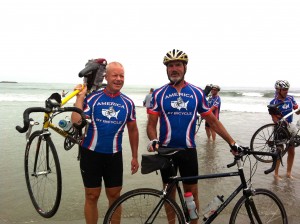Information Avoidance and Persuasion
The 1989 Tour de France was decided in the last stage, a 15.2 mile time trial into Paris. The leader, Laurent Fignon, held a fifty second advantage over Greg LeMond. Both riders were strong time trialers. To make up fifty seconds in such a short race seemed impossible. Most observers assumed that Fignon would hold his lead and win the overall title.
In most time trials, coaches radio the riders to inform them of their speed, splits, and competitive position. In this final time trial, however, LeMond turned off his radio. He didn’t want to know. He feared that, if he knew too much, he might ease up. Instead, he raced flat out for the entire distance, averaging 33.9 miles per hour, a record at the time. In a stunning finish, LeMond gained 58 seconds on Fignon and won the race by a scant eight seconds. (Here’s a terrific video recap of the final stage).
LeMond’s strategy is today known as information avoidance. He chose not to accept information that he knew was freely available to him. LeMond knew that he might be distracted by the information. He chose instead to focus solely on his own performance – the only variable that he could control.
While information avoidance worked for LeMond, the strategy often yields suboptimal outcomes. We choose not to know something and the not knowing creates health hazards, financial obstacles, and a series of unfortunate events. Here are some examples.
- In a study of 7,000 employees at a large non-profit organization, Giulio Zanella and Ritesh Banerjee found that women are less likely to get a mammogram when one of their co-workers is diagnosed with breast cancer. The mammogram rate dropped by approximately eight percent and the effect lasted for at least two years. (Click here).
- Amanda Ganguly and Josh Tasoff offered students tests to determine if they carried the herpes simplex virus. Though the tests were free and readily available, about five percent of the students refused the test for the HSV1 form of the virus. Fifteen percent refused the test for the HSV2 form of the virus, which is widely regarded as the “nastier” version. In other words, the scarier the disease, the more likely people are to avoid information about it. (Click here).
- Marianne Andries and Valentin Haddad investigated similar effects in financial decisions. They found that “…information averse investors observe the value of their portfolios infrequently; inattention is more pronounced …in periods of low or volatile stock prices.” Again, the scarier the situation, the less likely people are to search for information about it. (Click here).
- Russell Golman, David Hagmann, and George Loewenstein also investigated economic decision making and identified five information avoidance techniques: 1) physical avoidance; 2) inattention; 3) biased interpretation; 4) forgetting; 5) self-handicapping. (Click here).
In some ways, information avoidance is the flip side of the confirmation bias. We accept information that confirms our beliefs and avoid information that doesn’t. But there seems to be more to avoidance than simply the desire to avoid disconfirming information. Other contributors include:
- Focus and fatalism – why learn something that we can do nothing about? I suspect that this was LeMond’s motivation. He couldn’t do anything about the information, so why receive it? Instead he focused on what he could do.
- Anxiety – why learn something that will simply make us anxious? The scarier it is, the more anxious we’ll be. We’ve all put off visits to the doctor because we just don’t want to know.
- Ego threat – why learn something that will shake our confidence in our own abilities? It seems, for instance, that poor teachers are less likely to pay attention to student evaluations than are good teachers.
Information avoidance can also teach us about persuasion. If we want to persuade people to change their opinion about something, making it scarier is probably self-defeating. People will be more likely to avoid the information rather than seeking it out. Similarly, bombarding people with more and more information is likely to be counter-productive. People under bombardment become defensive rather than open-minded.
As Aristotle noted, persuasion consists of three facets: 1) ethos (credibility); 2) pathos (emotional connection); 3) logos (logic and information). Today, we often seek to persuade with logos – information and logic. But Aristotle taught that logos is the least persuasive facet. We typically use logos to justify a decision rather than to make a decision. Ethos and pathos are much more influential in making the decision. The recent research on information avoidance suggests that we’ll persuade more people with ethos and pathos than we ever will with logos. Aristotle was right.
Greg LeMond’s example shows that information avoidance can provide important benefits. But, as we develop our communication strategies, let’s keep the downsides in mind. We need to package our arguments in ways that will reduce information avoidance and lead to a healthier exchange of ideas.
Beauty and Success

Who’s fastest?
Let’s say you interview a candidate for a managerial position in your company. She’s incredibly smart, with an IQ in the 95th percentile. Because she’s so smart, you conclude that she’ll make a great manager. You hire her.
What mistake have you just made? I usually call it the halo effect, a term coined by the psychologist Edward Thorndike. You form a favorable impression about a person – because she’s smart – and therefore assume that she would have other positive attributes – like being a good manager. It’s as if she were wearing a halo. The fallacy is that the attribute you observe may not be related to the attribute you assume. In our example, just being smart doesn’t necessarily mean the candidate will be a good manager – it takes a lot more than intelligence.
We often see the halo effect with physical attractiveness. (The technical term is the physical attractiveness stereotype). There’s been a wealth of research that shows that attractive people are generally more successful than less attractive people. You might expect this in the fashion industry, but it also seems to be true in politics, law, business, and medicine – fields where physical beauty wouldn’t seem to be related to performance. (For a general overview of such research, click here).
Until recently, I’ve assumed that the physical attractiveness stereotype is just a special case of the halo effect. People assume that an attractive person is also good at other (often unrelated) activities. Because observers make that assumption, the attractive person may get more opportunities to advance than a less attractive person. It’s not the beautiful person’s fault. It’s a cognitive bias from observers.
But what if it’s not? What if the genes that make a person attractive also make him or her more athletic, more competent, and more intelligent? What if beautiful people really are more capable than us average shmoes?
Erik Postma’s recent research seems to point in exactly that direction. Postma studied the relationship between attractiveness and success in the Tour de France bicycle race. If physical attractiveness separates the winners from the losers in such a grueling event, it would strongly suggest that the underlying mechanism that causes attractiveness also provides other advantages as well. Maybe beautiful people really are more capable.
And that’s exactly what Postma found. Postma asked 816 people (72% female) to rate the attractiveness of 80 riders in the 2012 Tour de France. He then correlated attractiveness to success in the race. After a lot of statistical manipulation, he found that “the top 10% of cyclists in the race were reckoned 25% more attractive than the bottom 10%.” (Postma’s original article is here. Popular summaries are here, here, and here. For an interview with Postman about his article, click here.)
As always, there’s still a lot to learn. For one thing, only men were rated. Does the same effect apply to women? Who knows? Additionally, women rated attractiveness somewhat differently than men. The riders rated most attractive by women were among the top cyclists in terms of overall endurance. The riders rated most attractive by men tended to be stronger at sprint events, where speed is more important than endurance. Why the difference? Again, who knows?
What does it all mean? It’s not completely clear but attractive people may just be more capable than less attractive people. The evidence is not strong but it’s enough to make me think that I should get a facelift before my next bike race.
